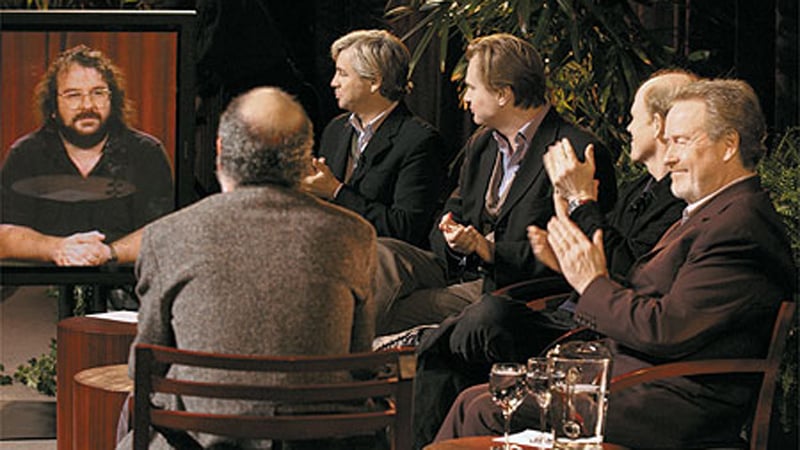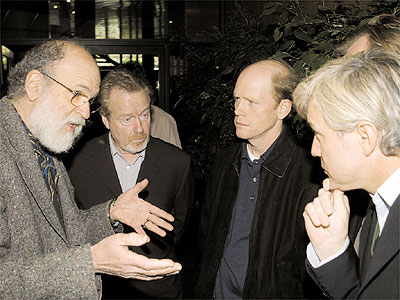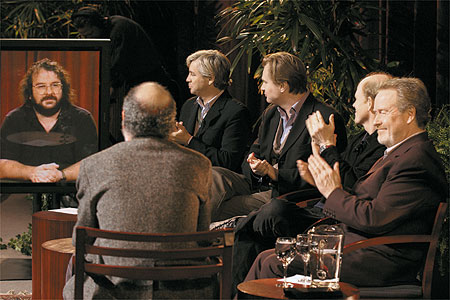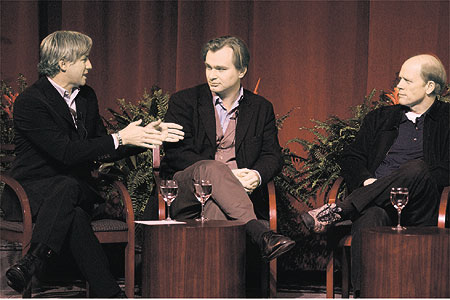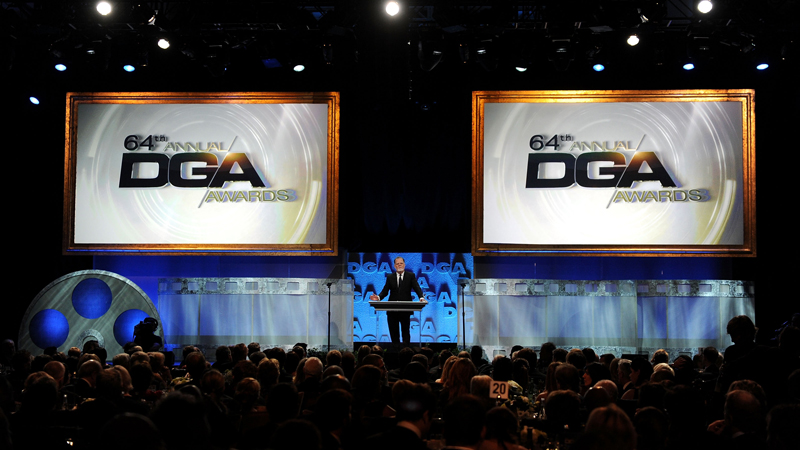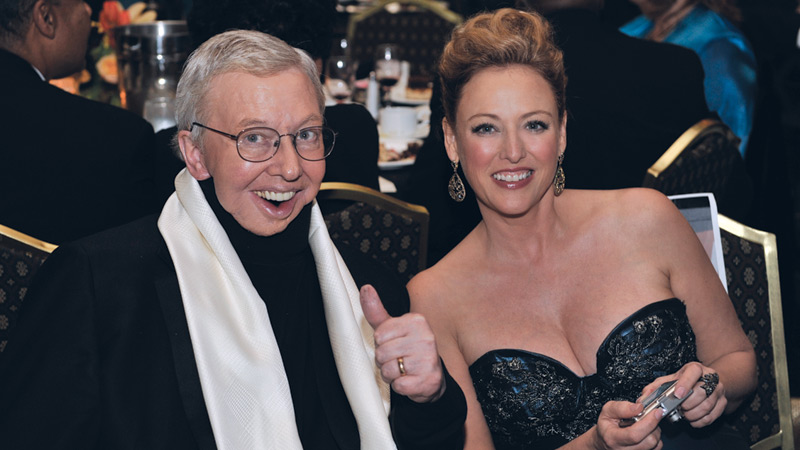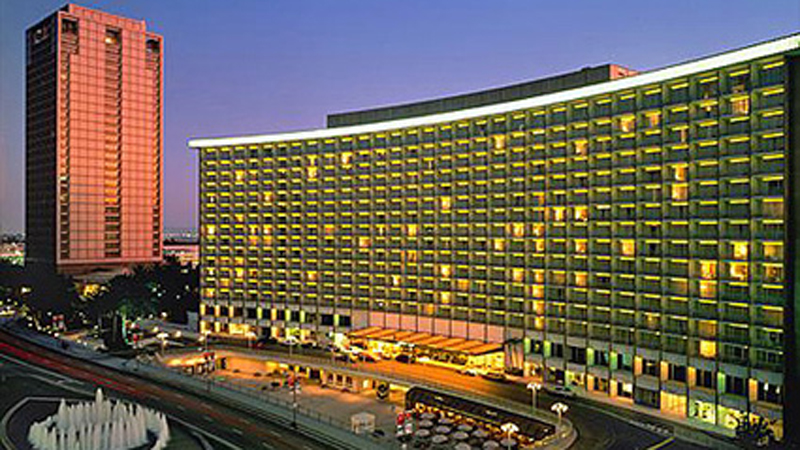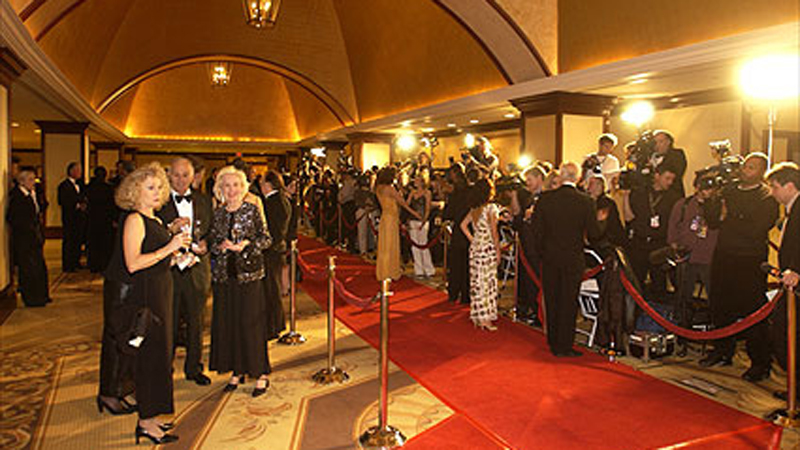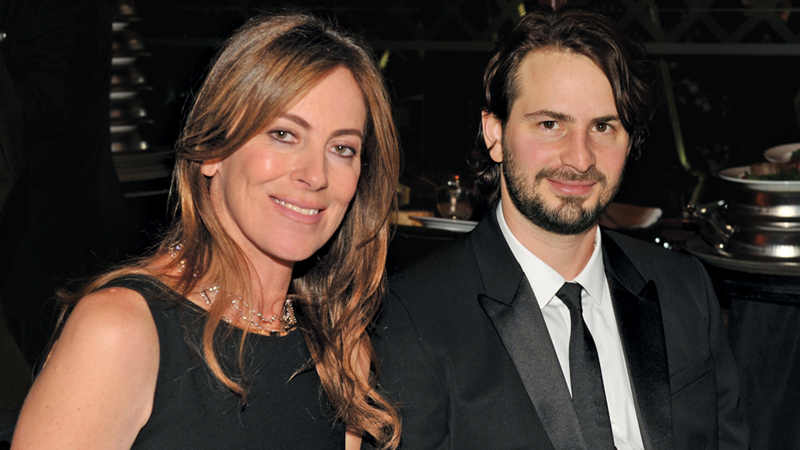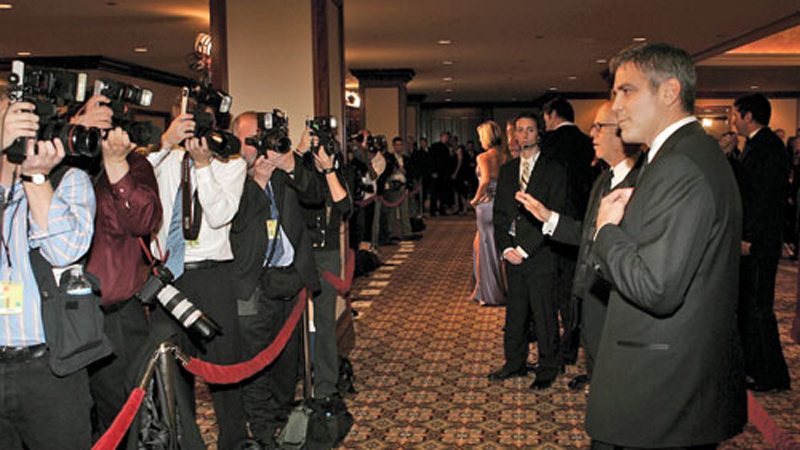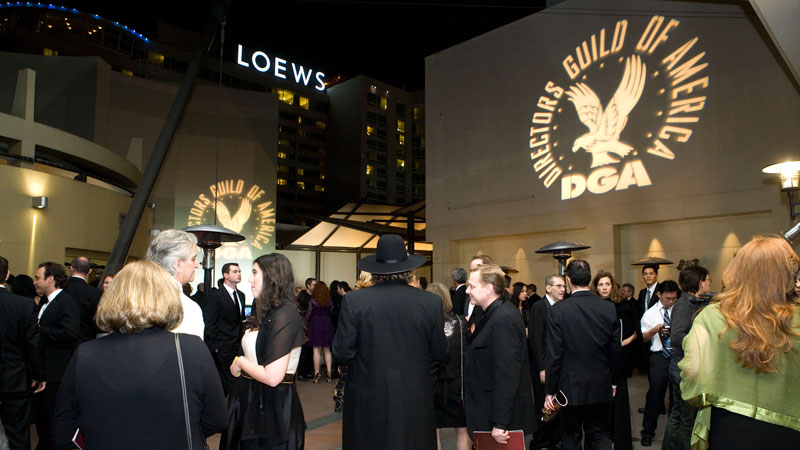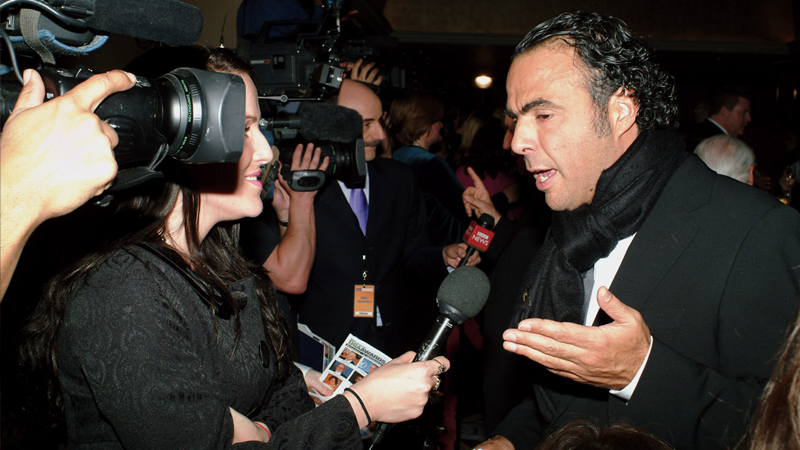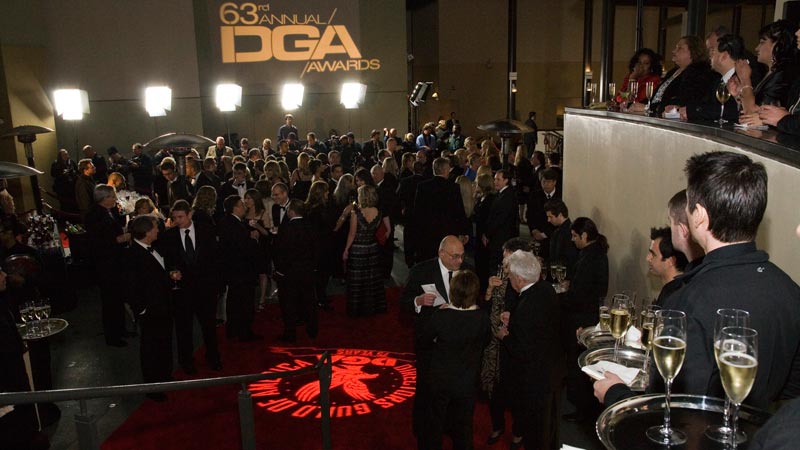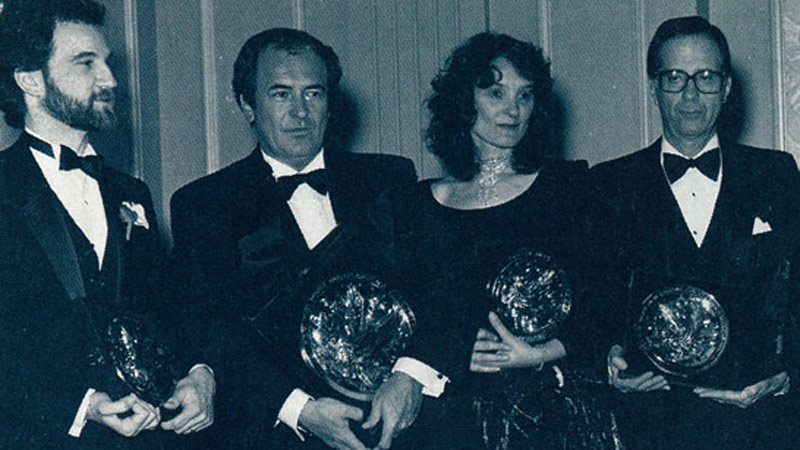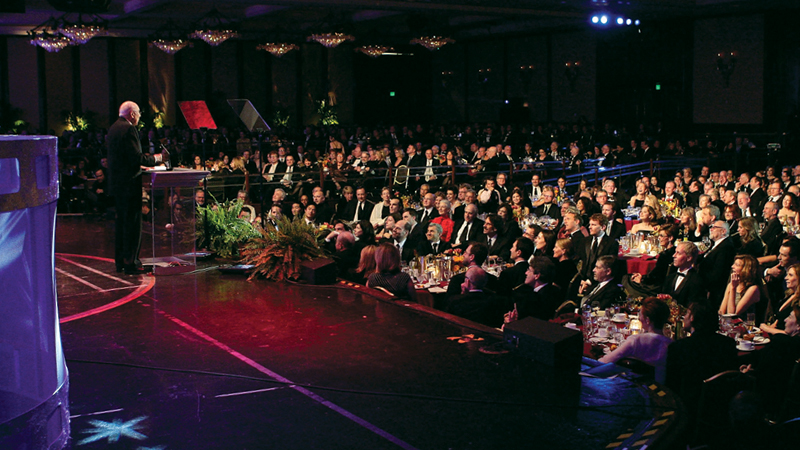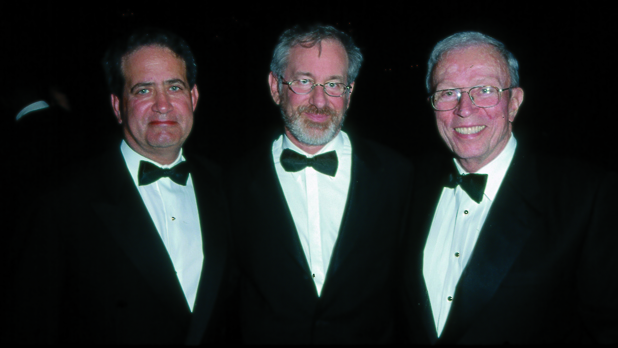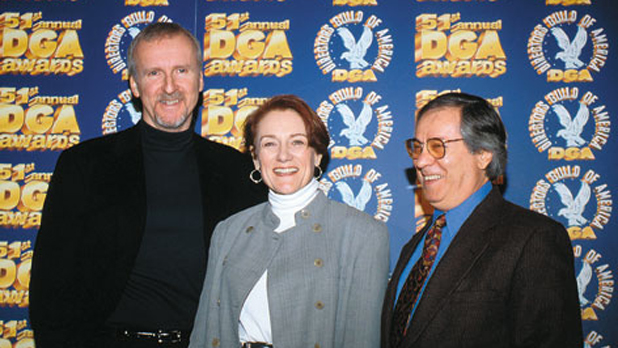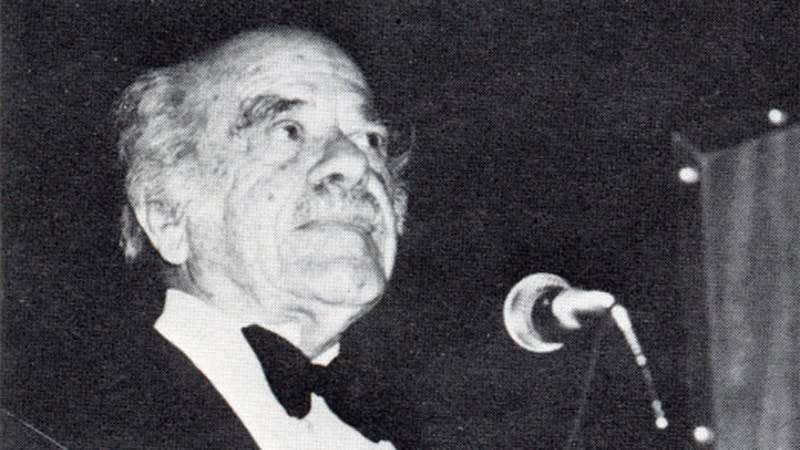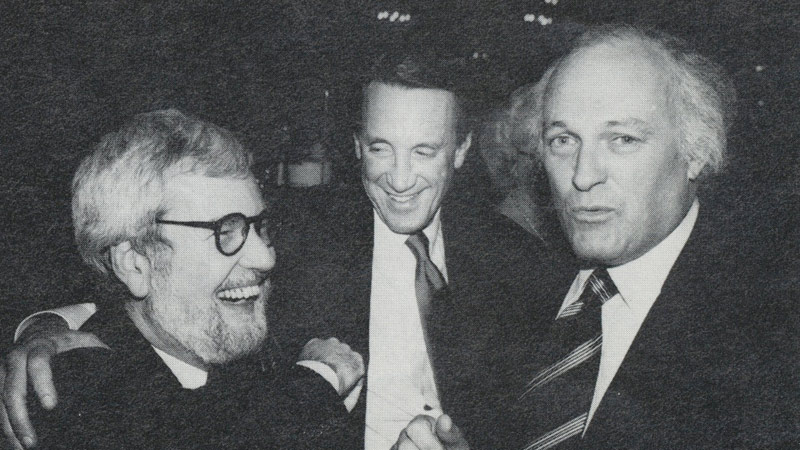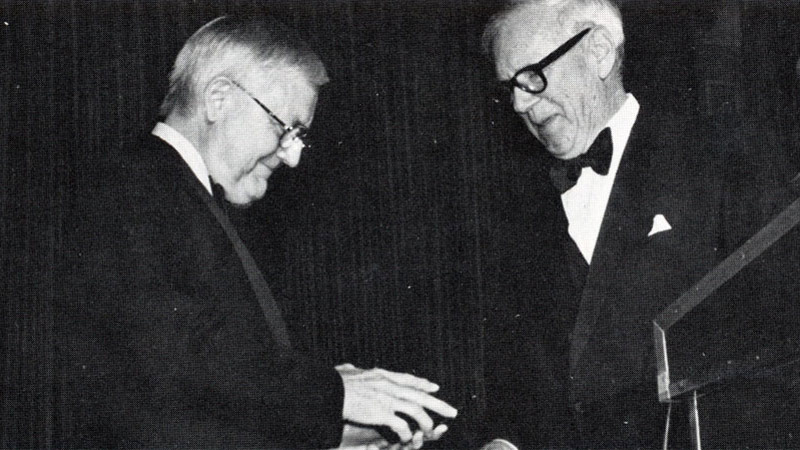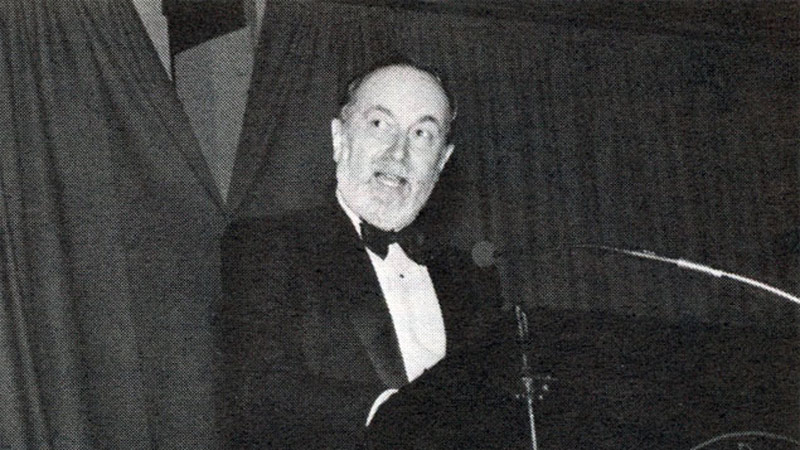The annual DGA Meet the Nominees Feature Films was held at the DGA on March 9. All five nominated directors — Ron Howard (A Beautiful Mind), Peter Jackson (The Lord of the Rings: The Fellowship of the Ring and attending via live video from New Zealand), Baz Luhrmann (Moulin Rouge), Christopher Nolan (Memento) and Ridley Scott (Black Hawk Down) — spoke about their nominated films and methods with moderator, DGA National Board Member Jeremy Kagan.
Former Guild President Jack Shea opened the proceeding by welcoming the newest DGA member, Baz Luhrmann.
Following a presentation of clips from each director's film, the panelists were asked to talk about mentors and how they each got started in the business.
Scott went first, citing John Ford (the early years), Michael Powell and Carol Reed as his mentors. Scott gave the audience its first laugh of the morning when he revealed that he was so crazy about Hollywood Westerns when he was growing up in the northeast part of England, that he seriously wanted to be a cowboy until he was 18.
"I think my parents thought I was retarded," Scott quipped. "I was very bad at school, but I could draw." It wasn't until Scott went to art school, where a mentor encouraged him to pursue commercial art and posters, that the world opened up for him.
Howard cited actor/directors Bob Sweeney, Lee Phillips and Richard Crenna as influences. "Since I spent a significant part of my childhood on set, I learned by osmosis," said the child star turned director. Howard also credited his father, who directed plays, Happy Days director Jerry Paris, American Graffiti director George Lucas, and Henry Fonda, who encouraged him to direct after seeing some of the young actor's Super 8mm movies.
Nolan admitted to making home stop-motion war movies as a kid, but without a tripod. His big influences came from Ridley Scott, George Lucas, Stanley Kubrick, Nicolas Roeg and Orson Welles.
"When I saw Star Wars, my world completely changed," Nolan said. "And Scott's Blade Runner made me realize that one mind could pull together different actors, scripts and stories. That was when I figured out what most closely approximated my idea of telling stories."
Like Scott, Baz Luhrmann grew up in "the middle of nowhere," loved Westerns, made home movies, and added an influential father. "My father ran the cinema in town for awhile, and the first adult film I saw was a Western called Paint Your Wagon. But, unlike Ridley, when I saw my second Western, I was like, 'Where's the singing?'"
Luhrmann credited many other Australian directors with teaching him the fundamentals of filmmaking, but said his one true mentor was his drama school coach. "He's a recluse now," explained Luhrmann. "His name is Jim Sharman, and he only made one film, The Rocky Horror Picture Show."
And like Nolan, Peter Jackson said that Star Wars also made a huge impact on him when he was a kid making Super 8 stop-motion films. The New Zealander also credits the British children's show The Thunderbirds, the 1933 version of King Kong, Jaws and Ray Harryhausen movies as his biggest influences.
"I was an only child, and I spent a lot of time alone building model spaceships," said Jackson. He borrowed his parent's Super 8mm movie camera when he was eight years old to film his models and added that he couldn't wait to get out of school to earn enough money to buy camera gear. "I couldn't get a job in the film industry in New Zealand, so I became a photo engraver and shot my feature film on Sundays for four years using fellow engravers as actors."
Next Kagan asked each participate to name their peak experience while making their films.
"A Beautiful Mind was the most difficult movie I've every made, not logistically, but in terms of being demanding," recalled Howard. "One of my goals was to get the key line of dialogue, 'I need to believe,' ring true. Nash's wife says this when she makes the courageous decision not to take him back to the hospital, but support and protect him at home. We tried out a lot of different ideas. At one point Russell dropped to his knee and put his hand on my chest ... he became Jennifer, and that's how we shot it. That was one of the most exciting days during the whole film for me. I remember ending that meeting thinking, 'This is what I love to do.'"
Nolan's peak experience was Memento's close-up where the protagonist reveals how frustrating it is not being able to remember things. "I had something I was happy with, and I asked [lead actor Guy Pearce] are you OK with it? He said, 'No,' so we did one more take. It was one of those moments where the actor is so in the moment that it was completely real for him. Suddenly, you realize with the right actor, the right role and the right time, you can have a lot of fun and not be all controlling. The other time would be shooting the reverse sequence for real. In the end, I found myself on my hands and knees blowing the shell casing out of the shot, and we just ran it backward."
For Luhrmann the peak experience occurred during Moulin Rouge's dance hall scene. "After four months of rehearsals and waiting, the tension was at an extraordinary level," Luhrmann recalled. "The can-can is a very difficult dance. I knew we'd be lucky to get them to do it three times, but I asked them to do it a fourth time, and dance up to the men and get them to dance. The girls threw their all into it, and for a few minutes after the music stopped, the cameras kept rolling. It became a real bacchanalian moment. For ten minutes we forgot all the pain, then we all went back to work, as if nothing had happened."
Jackson, who had just finished 15 months of filming the three Lord of the Rings films back-to-back, and out of sequence, laughed at the absurdity of trying to pull out a moment from just one of the films.
"By the time we started shooting, I'd been living with this movie for four years and we were still rewriting as we were shooting," Jackson said. "I'd say the thing I will remember the most is that the experience was a combination of careful planning, combined with make-it-up-as-you-go-along days."
For instance, Jackson didn't plan any weather cover for his first 1999 location shoot in Queenstown. "Our plan was just to keep shooting, even if it rained, but we didn't count on a storm washing the road to the location away. There are no big warehouses in Queenstown, so we asked the hotel if we could build a set on their squash court. The problem was the only set we felt we could build fast enough, that would fit, was for an intense scene in the third movie between Sam and Frodo. None of us had gotten our heads into the third movie. We shot Sam's angles first, so Elijah could get into character. By the end of the second day, Elijah was right into the scene and I said, 'Great, but the road is repaired, so we have to go back to the first film.' That set stood on the squash court for a year, and when we finally did go back, it was like trying to match old archive footage."
To help keep things on track during the four years of pre-production, Jackson credited his initial use of animatics. "It's a recorded audio version of the script that is cut together with storyboards, temp music score and sound effects. I made all the actors sit through this two and one-half hour home movie so they would know what film was floating around in my mind."
Jackson admitted to screening (with great trepidation) an animatic for Ian McKellen, who played the role of Gandalf. "He saw his role on film with Barbie dolls, and heard a New Zealand accent." Jackson had used a DV camera with a special lens the camera department carefully marked in order for him to equate his setups to real lenses, angles and distances.
Unlike Jackson, Ridley Scott, whose motto is, "just do it," felt the pressure of having only 15 weeks to shoot before a pending strike. "I remember Fred Astaire saying he never looked at his films once they were finished, so I never look back now," Scott said. "I've learned not to look at the possible problems, just look at when the start date is, and deal with the problems when they come at you. I always go in with a prepared notion, but I'm looking for something I hadn't expected, and I'll go for it."
Scott, who comes from a production design background, used storyboards.
"I had to," he pointed out. "We were using 11 cameras, and shooting mile-long takes. It's no secret that when we went to shoot, we only had the first act. We were constantly working through the last two acts over the phone.
"In a way, that helps you pay attention," Scott added. "I would rehearse on the floor, light and shoot. Coming from a commercial background, I'm very comfortable with that, but I don't think it's very fair for the actors." To ease that, Scott gathered everyone around him each morning prior to shooting to bring them up to date. "With Hannibal I was able to do a conventional rehearsal, but Black Hawk was this incredible jigsaw puzzle centered around an event. Things were in a constant state of flux."
Casting and rehearsals were the next topics covered during the three-plus-hour event. Howard says this is the phase of the filmmaking process he really despises.
"With key roles, I try to see how flexible and inventive they are going to be, and whether or not they are going to be a big pain in the ass," Howard told a sympathetic audience. "Sometimes, someone comes in, and you know instantly that's it. Paul Bettany was that way — and the character wasn't even written British. Jennifer Connelly, on the other hand, really won the role. She went to Yale and Stanford, and after spending some time with her, I felt she really understood the role."
While Howard and Scott's casting had to be sensitive to the real-life characters the scripts were based on, Jackson had the equally taxing job of casting characters that are so familiar to fans. One lead-casting mistake could cost the credibility of all three films.
"Fortunately, all of our first choices for the leads said 'Yes,' but we still had the Hobbits and Elves and other creatures to cast," explained Jackson. "I don't think looking at tapes tells me a great deal, so I did a lot of auditions. We decided to cast regular-size actors and, through effects, shrink or stretch them to fit the roles, but we found there were some physical constraints. We did a test on our crew to see who would look the best as a Hobbit or Elf. We found that, to look good as a Hobbit, the actors should be between five feet and five feet seven. We cast for tall and lean body proportions when we picked the Elves.
Luhrmann also relied on special effects to get the diminutive size of his Toulouse-Lautrec character. "John Leguizamo really wanted the role," recalled Luhrmann. "He got down on his knees and chased me around the Chateau Marmont doing his Lautrec impersonation until I said OK. I felt the illusion of his height was less important than the fact that he could act the role and engage with other actors."
Scott had the formidable challenge of distilling down 75 key characters in the book to 35 actors. "I drive casting directors mad because I ask the actor to tell me about the part, and then I see if he or she can bring anything interesting to it," Scott said. "Of course, the key thing to making it believable was to send them all to Delta training camp for three weeks. By the time I met them in Africa, they all saluted me."
Nolan found pre-production and casting to be quite different from his pervious indie film experiences. "I would always watch movies and notice how weak many of the secondary characters were, but I've found there's a certain amount of luck involved to getting a performance out of them in the take you want to use. The reality is they wait around all day to get 20 minutes at the end of the day, and you have to concentrate on the main actor's performance."
"Instead of auditions, I do workshops," Luhrmann said. "I try to get the actor so involved they forget they're auditioning.
"Moulin Rouge had a long pre-production period where actors as well as production department heads helped in the script's evolution. We had four months of full-time rehearsals," he recalled. "Dance and scene workshops every day until they got to the place where they possessed the script, and could tell it just as well as I could. There's no question, if we hadn't been involved in this extra effort, I wouldn't be here today in front of the DGA."
To wrap up, Kagan asked each director to reveal the best and worst thing about being a director.
"The best thing about being a director is imagining a movie you'd love to see and putting the jigsaw puzzle together so it meets that expectation," Jackson said. "The worst thing about the job always revolves around the weather. Getting snowed on."
Luhrmann agreed with Jackson about the best part of the job. "But, the worst part is the responsibility. It's one thing to commit to doing something for five years of your life, another to take others along on the journey."
Howard also cited the pleasure of the adventure and the pressures of the responsibilities as best and worst things about the job. "Certainly, there's pressure and days when I wish it wasn't snowing on my head, but I like this job, and I try not to let on if it's not happening that day."
Without hesitation, Nolan said that for him both the best and worst thing about directing was finishing a film.
Scott agreed and added, "The worst part is also committing to something and being sure something better is just around the corner, as well as thinking you're going to be out of work when it's over."
–Mary Hardesty
